|
PERIODONTAL DISEASE AND DENTAL HOME CARE

(“Perio” means around, “Dontal” means tooth:
“Periodontal disease” is disease around the outside of the tooth)
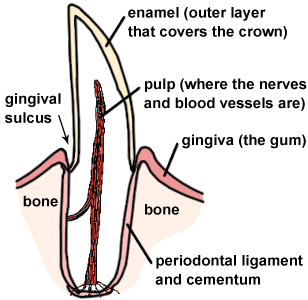
(original graphic by marvistavet.com)
THE TOOTH, THE WHOLE TOOTH AND NOTHING BUT THE TOOTH
In this picture we see the crown of the tooth (the part we see when looking in the mouth),
the root of the tooth (the part we do not see), and the attachment of the tooth to the bone.
The tooth sits in a “socket” and is held there by periodontal ligaments.
The tooth receives nutrients from blood vessels inside the pulp chamber of the tooth.
Periodontal disease takes place inside the socket in which the tooth is seated.
|
Out of all the members of one’s family, the chances are it will not be difficult to guess who has the worst dental hygiene: the pets. They do not brush their teeth nor do they floss and this goes on for years. If you are ever curious as to what happens if teeth go for years without brushing (or you want to show your children what will become of their teeth should they fail to brush regularly), you have only to look at your pet’s teeth and smell your pet’s breath.
|
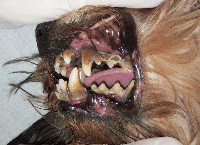
(Photocredit: Uwe Gille via Wikimedia Commons)
|
A full 85% of pets have periodontal disease by age 3 years.
|
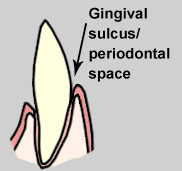
The space between the tooth and gum is the "gingival sulcus" or "periodontal space".
(original graphic by marvistavet.com)
|
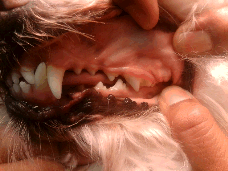
Normal mouth in a young dog.
(original graphic by marvistavet.com)
|
In the normal mouth, the teeth are clean and white and the gums attach smoothly to the tooth. There is no redness or tartar. The tooth is bathed in saliva, bacteria and food particles ("plaque") but if this is brushed away, it never mineralizes into tartar.
|
|
|
|
|
|
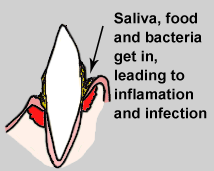
Saliva, food & bacteria (all of which collectively form "plaque") collect in the gingival sulcus leading to inflammation and infection.
(original graphic by marvistavet.com)
|
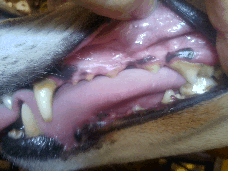
Plaque has mineralized into tartar at the gum line.
(original graphic by marvistavet.com)
|
If we do not regularly disinfect our mouths and brush away the plaque, the plaque will mineralize into tartar (also called “calculus” – gritty material which the dental hygienist scrapes away). Tartar, being solid and gritty, blocks oxygen from bathing the outer tooth and thus changes the nature of the bacteria that can live around the tooth. Inflammation and tenderness result in the gingival sulcus.
|
|
|
|
|
|
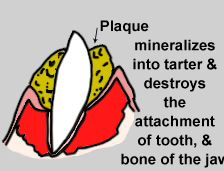
Tartar builds up covering most of the crown of the tooth as well as the attachment of the tooth root below the gum.
(original graphic by marvistavet.com)
|
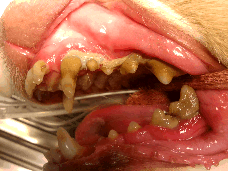
Note the redness and swelling where the gums and teeth meet. Tartar is heavy.
(original graphic by marvistavet.com)
|
Plaque mineralizes into tartar (also called "calculus"), creating more inflammation, covering the crown of the tooth, and destroying the attachment of the tooth and the surrounding jaw bone. When this mouth was cleaned up, many of these teeth could not be saved.
|
Worse still, the bacteria of the mouth can seed other areas in the body leading to infection in the heart, liver, kidney or virtually anywhere the bloodstream carries them.
In short, if regular home care is not performed on teeth, plaque will mineralize in the gingival sulcus, accumulate and destroy the attachment of the tooth. The tooth will be lost and the jaw bone can potentially break or even disintegrate (a serious problem in very small dogs). Worse still, the bacteria of the mouth can seed other areas in the body leading to infection in the heart, liver, kidney or virtually anywhere the bloodstream carries them.
Gingivitis is reversible. Bone loss, once it starts, is not reversible.
WHAT TO DO ABOUT PERIODONTAL DISEASE:
Fortunately, there is a lot we can do to prevent periodontal disease and the rules are basically the same whether the teeth belong to a pet or to a human being: Professional Cleaning and Home Care. Expect your pet to need a professional teeth cleaning every 6-12 months and expect general anesthesia to be necessary for each tooth to receive proper attention and care.Home care is ideally a daily part of tooth maintenance but even brushing just twice a week can remove most plaque before it can mineralize into tartar. Not every pet is amenable to hands-on oral care and not every person's schedule is amenable to it either so there are some lower maintenance options which we will review as well.
It is a good idea to become comfortable opening your pet’s mouth and looking inside. Lift the lip and look at the teeth, especially the back teeth. Open the mouth and look at the inside of the teeth and at the tongue. If you have pets of different ages, compare what you see inside. Many pet owners have never looked at their pet's teeth and are surprised at what they see. If your pet is cooperative, get used to working with your pet's mouth as this will be central to home care and will help you assess your pet's oral situation.
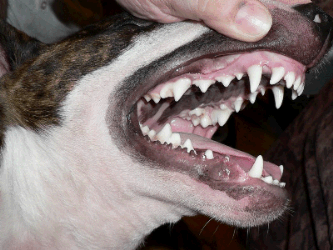
(Photocredit: Ivob via Wikimedia Commons)
Be sure to look at the back teeth as this is where tartar is usually the heaviest.
If you see tartar deposits, it is probably time for a professional teeth cleaning.
REGULAR PROFESSIONAL CLEANING
It should not be surprising that dental health requires period professional cleaning regardless of whether the mouth in question belongs to a person, a dog, a cat, a horse, or some other animal. Home care of the tooth is never perfect and periodically tartar must be properly removed and the tooth surface properly polished and disinfected. The professional cleaning performed at the veterinarian’s office is similar to what a person receives at their dentist’s office:
|
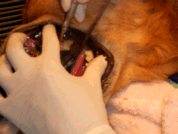
Scaling
|
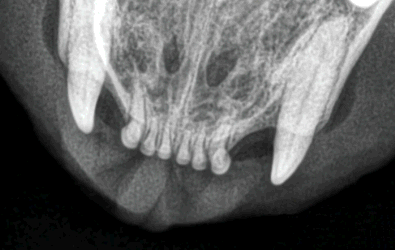
Radiography
|
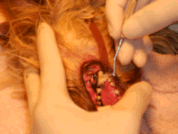
Probing
(all three original graphics by marvistavet.com)
|
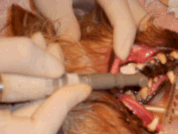
Polishing
|
- Gross tartar is removed with special instruments.
- More delicate tartar deposits are removed from the gum line with other special instruments.
- Periodontal sockets are probed and measured to assess periodontal disease.
- The teeth are radiographed to check for periodontal bone loss, root abscesses and other abnormalities.
- Teeth that cannot be saved are extracted.
- The roots are “planed,” (meaning tartar is scraped from below the gum line) until the roots are smooth again.
- The enamel is polished to remove any unevenness left by tartar removal.
- The mouth is disinfected and possibly treated with a fluoride sealer or plaque repellent.
- Professional notes are taken on a special dental chart, noting abnormalities on each of the dog’s 42 teeth, or cat’s 30 teeth.
IMPORTANT
|
It is important to note that “non-anesthetic” teeth cleaning
is not comparable to the above service.
It is not possible to perform the “multi step” cleaning in a pet
without general anesthesia.
Cosmetic cleanings do not address periodontal disease
where it occurs: under the gum line.
|
|
HOME CARE AND HOME CARE PRODUCTS
|
Toothpaste and Brushing
Just as with your own teeth, nothing beats brushing. The fibers of the toothbrush are able to reach between teeth and under gums to pick out tiny deposits of food. A toothbrush acts as a tiny scrub brush for the closest possible cleaning.
Notice the shape of the canine and feline brushes and how they conform to a pet's mouth. You can use a human toothbrush but you will probably find it difficult to manipulate in the pet's mouth. Never use a human toothpaste for a pet as these contain sudsing agents (people like to see foam when they brush their teeth) which are not meant to swallowed in quantity. Animal toothpastes come in special flavors (chicken, seafood, and malt) in addition to the more human-appreciated mint and all are expected to be swallowed.
Finger brushes are available and are smaller for puppies and kittens.
|
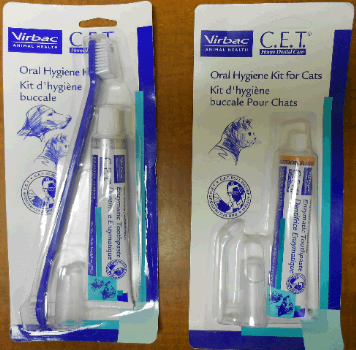
(original graphic by marvistavet.com)
|
Studies have shown that brushing three times a week was adequate to maintain
healthy teeth and gums but daily brushing was needed to control existing gingivitis.
DO'S AND DON'TS OF BRUSHING YOUR PET’S TEETH
DON'T USE A HUMAN TOOTHPASTE ON YOUR PET.
DO USE A TOOTHBRUSH WITHOUT ANY PASTE AT FIRST SO THAT YOUR PET MAY GET USED TO THE OBJECT IN THE MOUTH BEFORE HAVING TO CONTEND WITH FLAVOR.
DON'T ATTEMPT TO CLEAN THE INNER SURFACE OF YOUR PET'S TEETH. NATURAL SALIVA CLEANS THIS SURFACE ON ITS OWN.
DO TRY TO PERFORM DENTAL HOME CARE AT LEAST ONCE DAILY.
DON'T PERFORM DENTAL HOME CARE DURING THE FIRST WEEK AFTER A FULL DENTISTRY IN THE HOSPITAL AS YOUR PET'S GUMS MAY BE TENDER.
DON'T CONSIDER DENTAL HOME CARE AS AN ALTERNATIVE TO FULL DENTAL CLEANING IF YOUR PET HAS MORE ADVANCED DENTAL DISEASE.
Need help with technique? Here is the AVMA's video on how to brush:
|
Dental Wipes, Rinses, Sprays and Pads
Some animals, especially those with tender gums, will not tolerate brushing but are more amenable to disinfecting wipes or pads. These products will wipe off plaque deposits from the surface of the tooth and, though they lack the ability to pick food particles out of the gum socket, they are probably the next best thing to brushing and, like brushing, these products are best used daily.
Oravet Plaque Preventive Gel®
This product addresses the convenience factor of pet dental care. Doing anything in a pet’s mouth daily year after year is a difficult habit for most people to establish. We have enough trouble taking care of our own teeth. Oravet is a wax-like substance applied once a week to the outer surface of the teeth with a swab (though it can be used even daily for pets with particularly bad gingivitis). Oravet prevents plaque from attaching to the tooth and provides a helpful mode of dental care on an easy to follow schedule.
|
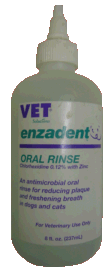
(original graphic by marvistavet.com)
|
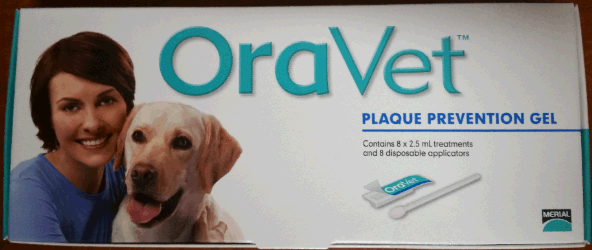
(original graphic by marvistavet.com)
To see how to use Oravet Gel:
|
Water Additives
A couple of spoonfuls of dental water additives in your pet's drinking water help prevent plaque attachment and bad breath. This is not going to be as complete as brushing the teeth but it helps with redness and gingivitis similar to the way a mouth wash might work for a person. Some animals simply will not allow any sort of mouth manipulation and a dental water additive can be very helpful in this situation. Alternatively, the water additive product may be a good addition to a regimen using the other dental products.
|
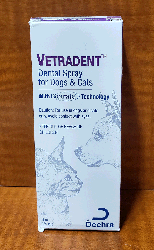
(original graphic by marvistavet.com) |
Dental Treats
For many people, doing anything inside their pet’s mouth on a regular basis is simply never going to happen. Fortunately, all is not lost: chewing on a proper dental chew daily can substantially reduce plaque and tartar by up to 69%. Chews should be used daily in order to achieve these results; occasional use is not going to be helpful and the dog must actually chew on the treat.
Dental chews must be the proper size for the dog in question to avoid a choking hazard and can have sophisticated additional ingredients. Examples include ingredients to prevent mineralization of plaque (i.e. hexametaphosphate in C.E.T. Dentahex chews) or to prevent future plaque attachment after current plaque is rubbed off (delmopinol in Oravet brand chews), and green chlorophyll to help with bad breath.
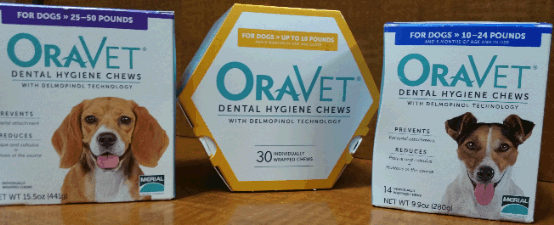 (original graphic by marvistavet.com) (original graphic by marvistavet.com)
Dental Diets
There is a common misconception that simply feeding a kibbled diet will protect the teeth from dental disease. Consider what it would be like to attempt to replace brushing your own teeth with eating crunchy foods and it is easily see how ineffective this method would be. When it comes to pet foods, much of the kibble is swallowed whole and not chewed at all.
|
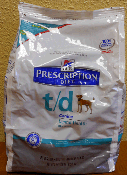
(original graphic by marvistavet.com)
|
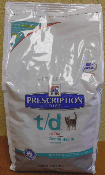
(original graphic by marvistavet.com)
|
Clearly, there must be more to a dental diet than simple kibbling and in fact there is. Dental diets on the market today use several techniques to help reduce plaque. The first is that the kibbles are very large which means the pet must chew them before swallowing them. These diets are high in fiber which means the kibbles do not shatter when chewed but instead the tooth sinks into the kibble allowing plaque to be essentially scrubbed away. The large kibbles may pose an acceptance problem for the pet leading the owner to use them as treats or mixed with other kibbles. The smaller the percentage of the diet these kibbles represent, the less benefit will be reaped. It is also important to realize that these diets are helpful only in cleaning the molars and premolars (i.e. the chewing teeth) and do not help the fangs or incisors.
Greenies
|
The greenie is a green chew treat for dogs, found effective in removing plaque and is generally found highly palatable to dogs. The greenie has been reformulated using soy instead of wheat but still seems as irresistible as ever. The canine greenie is flexible while the feline greenie is crunchy. Both have been approved by the Veterinary Oral Health Council and daily use is needed to realize meaningful results.
|

(original graphic by marvistavet.com)
|
WHAT IS THE VETERINARY ORAL HEALTH COUNCIL?
The Veterinary Oral Health Council evaluates dental products made for pets to be sure they actually do what they say they are going to do with regard to plaque and tartar control. If a product passes their evaluation protocol, it is awarded the VOHC Seal of Approval.
For a list of products that have merited this award visit:
http://www.vohc.org
Use your judgment with chew toys.
A chew can be readily swallowed in a large chunk and lead to intestinal obstruction.
A pet with diseased teeth may break teeth on a hard chew.
COW HOOVES AND BONES ARE NOT APPROPRIATE CHEW TOYS
AS THEY ARE TOO HARD AND READILY BREAK TEETH.
Pig Ears are well loved by most dogs and have been known to have bacterial contamination.
Dogs with sensitive stomachs often do not tolerate the smokey flavor.
No studies have been performed regarding prevention of dental disease using pig ear chews.
Links of interest include:
www.greenies.com
oravet.com

Last updated: 3/18/2025
|